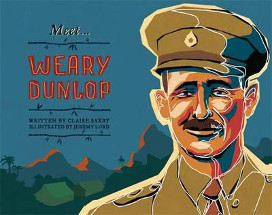Meet Weary Dunlop by Claire Saxby

Ill. by Jeremy Lord. Random House Australia, 2015. ISBN
9780857985361
Standing in the grounds of the Australian War Memorial in Canberra
is a statue of a man in a suit, a red poppy in his lapel and a hat
in his hand. It's a statue that hundreds of thousands of children
have seen, glanced at and moved on without knowing the significance
of the man it is a tribute to. Yet this is a person who played a
very important role in helping their grandfathers and
great-grandfathers stay alive as they endured the horrors of being
held prisoners of war by the Japanese Imperial Forces in World War
II.
As a child born before the outbreak of World War I, Ernest Edward
Dunlop lived an idyllic life in the country in Victoria but he was
always going to be too big for a small country town. A smart student
and expert sportsman he earned his nickname of Weary in a convoluted
word play and while many of his companions stayed in and around the
district, the outbreak of World War II found him working as a
surgeon in London. He immediately joined the Australian Army Medical
Corps and in 1942 he was in Java in charge of a military hospital
when it fell to the Japanese and he, along with many others, was
taken prisoner. Put in charge of British and Australian prisoners
working on the notorious Burma-Thailand railway being built so
Japanese troops could be moved overland instead of by sea, he did
what he could to barter, cajole and negotiate with his captors for
food, medicine and shelter for 'his' men. Even when it meant
personal punishment he always protected his men, often taking great
risks to ensure their survival. He made do with what he had, usually
woefully inadequate, forced to be inventive and creative, and
always, always with the welfare of his fellow prisoners at heart. As
they were starved and punished, he understood the importance of
morale and organised concerts and pantomimes to lift spirits as well
as encouraging others to keep diaries, draw, paint and photograph
the camp and the conditions. They made grim reading after the war
ended.
This is the latest in the Meet series, and, in my opinion,
one of the best. Sensitively written and illustrated for those who
have not seen the film footage of what really happened, it puts a
human face on a conflict that did much to shape Australia and her
post-war attitudes. There is enough information to satisfy the
curious with two or three of Dunlop's escapades adding a lightness
to such a dark topic, yet at the same time there is enough to tempt
a more serious reader into a deeper investigation. Australia has
many war heroes apart from John Simpson Kirkpatrick. Having read
this, perhaps the children who visit the AWM will spend a little
more time at that statue, pondering the extraordinary depths and
determination of the human spirit.
There are now eight titles in this series which is a must-have in
school libraries as it brings the lives of our heroes and
history-makers to life through accessible, illustrated texts in a
way that brings the biography genre to life. They add an extra layer
to an historical study and the accompanying teachers'
notes open up new ideas for exploration. They tell a story
rather than just providing clumps of facts and figures, and are
suitable for newly-independent readers as well as for those for whom
English is a struggle. As well as supporting the history strand of
the Australian Curriculum, they also provide a model for younger
students for writing a biography providing a purpose for reading and
research.
Barbara Braxton